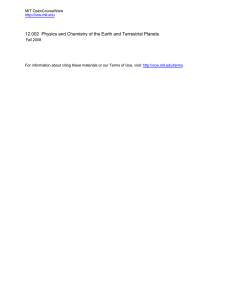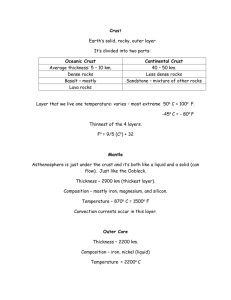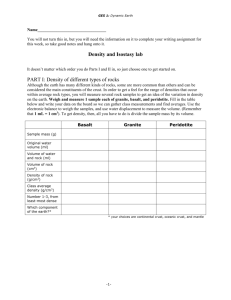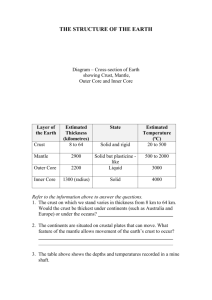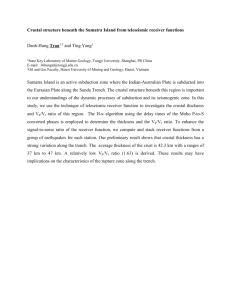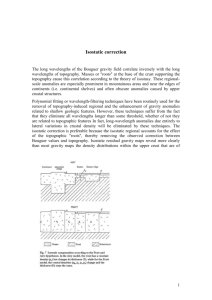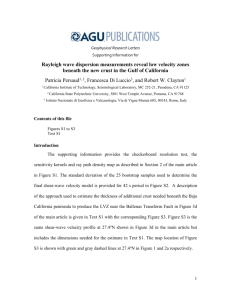Lab7_text - Earth & Planetary Sciences
advertisement
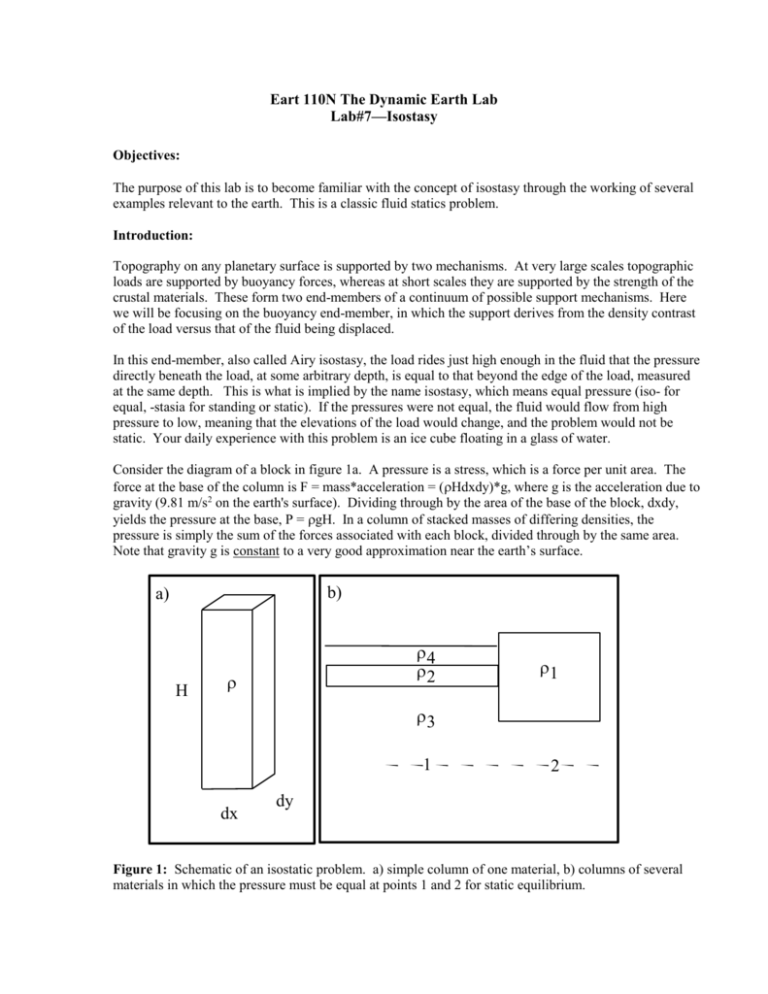
Eart 110N The Dynamic Earth Lab Lab#7—Isostasy Objectives: The purpose of this lab is to become familiar with the concept of isostasy through the working of several examples relevant to the earth. This is a classic fluid statics problem. Introduction: Topography on any planetary surface is supported by two mechanisms. At very large scales topographic loads are supported by buoyancy forces, whereas at short scales they are supported by the strength of the crustal materials. These form two end-members of a continuum of possible support mechanisms. Here we will be focusing on the buoyancy end-member, in which the support derives from the density contrast of the load versus that of the fluid being displaced. In this end-member, also called Airy isostasy, the load rides just high enough in the fluid that the pressure directly beneath the load, at some arbitrary depth, is equal to that beyond the edge of the load, measured at the same depth. This is what is implied by the name isostasy, which means equal pressure (iso- for equal, -stasia for standing or static). If the pressures were not equal, the fluid would flow from high pressure to low, meaning that the elevations of the load would change, and the problem would not be static. Your daily experience with this problem is an ice cube floating in a glass of water. Consider the diagram of a block in figure 1a. A pressure is a stress, which is a force per unit area. The force at the base of the column is F = mass*acceleration = (Hdxdy)*g, where g is the acceleration due to gravity (9.81 m/s2 on the earth's surface). Dividing through by the area of the base of the block, dxdy, yields the pressure at the base, P = gH. In a column of stacked masses of differing densities, the pressure is simply the sum of the forces associated with each block, divided through by the same area. Note that gravity g is constant to a very good approximation near the earth’s surface. b) a) H 4 2 1 3 1 dx 2 dy Figure 1: Schematic of an isostatic problem. a) simple column of one material, b) columns of several materials in which the pressure must be equal at points 1 and 2 for static equilibrium. Exercises: You are provided with a set of wooden blocks (c.f. crustal blocks on the earth), a foam layer (elastic lithosphere), a tank (asthenosphere) of fluid and a ruler. We will explore the dependence of the level at which these blocks float as a function of the type of wood, the thickness of the wood, and the shape of the wood. Be thinking of the analogy with the earth's crust, which can thicken due to compressional mountain building events (orogenies), thin due to extensional faulting or erosion, and change shape due to erosion that is non-uniform. 1a. Determine the density of the wood. Using a ruler, measure the total thickness of a piece of wood, then immerse it in the water, and measure how much of the wood sticks above the water – we call this the ‘freeboard’, and it is analogous to topography. The only other thing you need to know is the density of the fluid, here water, which of course has a density, water of 1000 kg/m3. What are the densities of the two types of wood (oak and pine), and what equation did you use to figure it out? In other words, show us your work. 1b. Float the foam layer and place the block upon it. Notice that the block flexes and sinks much less than in 1a, but because the same mass of water (= mass of the block) has to be displaced to support the loac, the sinking is distributed over an area much wider than before. Measure (approximately) the amount the freeboard of the block now that the load is distributed. This is more like what actually happens when a mass (glacier, volcano, ...) is imposed on the surface of the earth. 2a. Assume that this wood corresponds to crustal material of thickness H. In an orogenic pulse, the crust has been telescoped and piled up to double its thickness. How much will the topography, Z, change? First derive an expression for this, and then do the analogous experiment by measuring what happens to the topography (the freeboard) when we double the thickness of the crust (the wood). Use the pine blocks for this. Your expression for change in Z for H -> 2H: Your measurement: 2b. Note that the opposite occurs if we thin the crust by erosion. Write out an expression for the expected change in altitude of this crustal block if it is thinned from 2H to H. Now perform the experiment by noting the freeboard before and after removal of a block of equal thickness. Your expression for change in Z for 2H -> H: Your measurement: Note that the wood that was originally on the bottom has in fact experienced uplift. This is analogous to "uplift of rock induced by isostatic compensation for erosional unloading". If the densities involved in the crustal problem are: crust = 2700 kg/m3, mantle = 3300 kg/m3, calculate the ratio of the expected rock uplift to the thickness of crust eroded: 3. Finally, explore what happens when the local relief increases due to non-uniform erosion. Consider erosion of an originally flat plateau in such a manner that it turns into a classic V-shape characteristic of fluvial (river) settings. First, derive expressions for both the change in the mean elevation of the block, and the change in the elevation of the peaks, when a fluvial valley of depth L is eroded into the plateau. (Note that since it is a perfect triangle, the mean thickness of crust removed is simply L/2. Now perform the analogous experiment by first noting the elevation of the original block, and then taking off the triangle. Expected change in the mean elevation: Expected change in the peak elevations: Your measurements of mean elevation and peak change: For your reference, several of the isostatic problems you have just dealt with are discussed at length in an interesting and influential paper and can be downloaded from the class website: Molnar, P. and England, P., 1990, Late Cenozoic uplift of mountain ranges and global climate change: chicken or egg? Nature v. 346, p. 29-34. _____ Finally, write a brief, 250 word, abstract about the exercise and print it out on a separate piece of paper. Discuss how the theoretical results from your calculations compare with the experimental data, and make sure you connect the experiments to the real world they are supposed to mimic.
